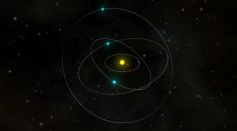Tags: White dwarf
Extraordinary Binary System with a Rapidly Spinning 'Dead Star' Whips Around Its Blisteringly Hot Stellar Companion
Two-Faced Star Discovered; White Dwarf Features Hydrogen on One Side, Helium on the Other
Crystallizing White Dwarf From a Quadruple Star System Turns Into a Cosmic Diamond

Hubble Telescope Gauges Mass of Lone White Dwarf Using Einstein's Gravitational Microlensing

Over 10-Billion-Year-Old Remnants of a Destroyed Solar System is the Oldest Ever Found in the Milky Way Galaxy

First-Ever X-Ray Fireball Phase of a White Dwarf Explosion Captured by eROSITA Telescope

Repeatedly Exploding Stat Produces Gamma Ray, What Is Stellar Vampirism?

Planetary Bodies Orbiting In the Habitable Zone of A Dying Star Observed For the First Time

Dying Moments of Planet While Being Consumed by White Dwarf Star Captured for the First Time
Hubble Space Telescope Reveals Knots, Filaments Wrapped Around White Dwarf; Gas Expanding Into Space Spotted

Supernova Remnant: Red Ribbon Explosion of a Dead White Dwarf Inside the Large Magellanic Cloud Captured by Hubble Space Telescope
White Dwarf From 1,400 Light Years Away Seen Switching On and Off for the First Time
White Dwarfs' Anti-Aging Secret Captured by Hubble Space Telescope's Wide Field Camera
Sun After Its Death: Scientists Predict How, When It’s Going to Happen; What Will the Solar System Look Like Then?
Supernova or Partner Star Effect? White Dwarf With Heavy Metals Blasts Opposite and Out of the Milky Way
How Can Planets Survive White Dwarf's Stellar Evolution? Signs of Life on Planet Near a Dying Star Impossible
White Dwarf Discovered to Have Greater Mass Than Sun, Astronomers Fear Sudden Collapse

1,000-Year-Old Mystery Explosion: Possibly Rare, Third Type of Supernova
Colossal Supernova Leftover Lying in Space: One-of-Its-Kind, Biggest Discovery in Astronomy
NASA Missions Find Survivor Planet Orbiting Remains of Dead Star
Most Popular

Orionids Meteor Shower Happening Next Week: Where and When To Catch the October Light Show's Peak

Texas Official Shot Down Siren Flood Alert, Complaining That It Might Go Off 'In the Middle of the Night': Report

Nvidia's Jetson Thor Could Make Humanoids Smarter Than Ever

Hellfire Missile Video Reveals MQ-9 Reapers Being Used for Aerial Combat




